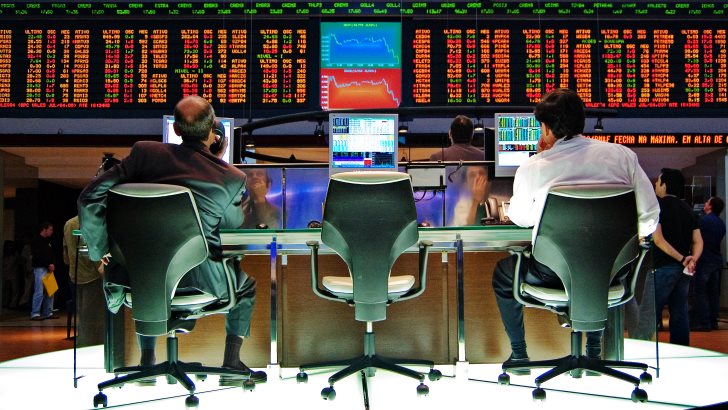
In trading, perceptions matter a great deal. More often than not, they matter even more so than what conventional logic would otherwise dictate. For instance, suppose a situation in which the majority of traders seems to be convinced for whatever reason that a given stock is bound to appreciate in the following days and weeks, even though it`s current value is obviously overpriced.
If the market were completely rational all of the time, the share price in question should correct itself. However, since things are seldom so clear-cut in real-life situations, traders' perceptions end up being the deciding factor in most such cases.
In other words, it matters most whether traders think that the glass is half full or half empty, even more so than the actual liquid volume currently in the glass. And when it boils down to perceptions, there is a distinct difference between how they affect uptrends and downtrends. But why is that?
At the most basic level, people seem to be attracted to rising prices. This is so because price appreciation is subconsciously associated with progress and improvement in a free-market environment. The conventional logic of trading dictates that it is a good thing to 'buy cheap and sell high', even though you can (almost) just as easily profit by selling high and then buying back your position low.
It is precisely this affinity to 'buy and hold' - type strategies amongst the vast majority of traders, leading to the frequent creation of massive uptrends in the longer-term. In contrast, downtrends tend to be much more abrupt and volatile. A downtrend could cover the same distance an uptrend would traverse much faster. This also has to do with mass-market psychology and the impact of typical traders' perceptions.
Falling prices also trigger a sub-conscious response in many traders. In contrast to the somewhat soothing effect of rising prices, depreciating markets tend to alarm traders. They incite a feeling of uneasiness and concern that something is not as it should be. Consequently, traders become much more likely to have an emotional response and panic-close their underlying positions. When this mass-market behaviour takes place on a large enough scale within a relatively narrow period, the result tends to be a massive downtrend.
It is important to remember that such traders' perceptions tend to drive markets up and down, and that is why they frequently end up serving as substitutes for conventional logic. This is not necessarily a bad thing, as understanding how the rest of the market feels at any given point in time could help you appreciate the market behaviour for what it is and not what it should be.
Trendsharks Premium
Gold is undergoing a correction, as investors take profits to offset losses from falling stock prices, impacting their margins. However, we anticipate a renewed wave of [...]
The Swiss stock market index is mirroring its global counterparts, such as Germany 40 and US100, experiencing a sharp decline following the announcement of new [...]
We’re analyzing the weekly chart to grasp the broader market trend. Over the past three years, the US30 index has surged by 17,000 points, often resembling a nearly straight [...]
Over the past week, the DAX has experienced a sharp decline, plunging by an astonishing 3,400 points. This downward movement is not isolated, as its international counterparts, such as the UK100 and US100, are also facing significant [...]
EURUSD recently formed a double top at 1.0930, signaling a potential trend reversal, and has since begun a correction. After a 600-pip rally since early March, a pullback at this stage is both expected and healthy. Given these conditions, we are placing a [...]
Since early March, EURJPY has surged nearly 1,000 pips, providing us with several excellent trading opportunities. However, as the rally matures, many early buyers are beginning to take profits, leading to a noticeable slowdown in the uptrend. On Friday, the pair formed a [...]
The AUDJPY currency pair continues to be dominated by bullish momentum, as multiple golden cross patterns reaffirm the strength of the ongoing uptrend. Despite this, we are witnessing a much-needed [...]
The EURAUD currency pair appears to be undergoing a trend reversal, signaling a potential shift in market direction. A notable technical development is the formation of a Death Cross on the chart, a widely recognized bearish indicator that typically suggests a [...]
After securing an impressive 200-pip profit last week, the EURJPY currency pair is now undergoing a southward correction, retracing some of its recent gains. Despite this temporary pullback, the Golden Cross remains intact, reinforcing our view that the overall trend continues to be [...]
The appearance of a Golden Cross in Silver strengthens our analysis that the metal is currently in a strong uptrend, indicating further bullish momentum in the market. This technical pattern, where the short-term moving average crosses above the [...]
This trade presents a considerable level of risk and can be classified as an opportunistic move based on recent price action. The GBPUSD currency pair has experienced a substantial bullish rally, surging by nearly 500 pips in a strong upward movement. However, after this extended period of appreciation, the pair is showing signs of a potential [...]
The anticipated Death Cross on the SMI20 appears to be failing as price finds strong support at the 23% Fibonacci retracement level. After testing this area, the index has shown bullish strength, printing several large green candles, signaling an increase in [...]
A Golden Cross has just appeared on the USDJPY chart, signaling a potential bullish move. This technical pattern occurs when the 20 period moving average crosses above the 60 period moving average, a widely recognized indication of increasing [...]
After 2 months of a down trend, we finally see some indications of price recovery for Oil. The golden cross, a historic buy signal, supports this [...]
For the past month, the German DAX40 has experienced a remarkable 10% surge, reflecting strong bullish momentum. Despite ongoing market volatility and frequent pullbacks, every dip continues to attract fresh buyers, reinforcing the [...]
Oil continues its downward trajectory, despite occasional pullbacks. The overall trend remains bearish, reinforced by multiple Death Cross patterns, a classic sell signal indicating further weakness. Adding to this bearish outlook, the critical [...]
Over the past few days, gold has experienced a sharp decline of more than $100. This downturn can be attributed in part to traders securing profits to manage their margins, which are under strain due to the significant drop in major indices. Currently, gold has fallen below the [...]
The NASDAQ 100 index is showing strong bullish momentum, as evidenced by the formation of a Golden Cross on the chart. This classic buy signal occurs when the short moving average crosses above the long term moving average, suggesting that upward momentum is [...]
The EURAUD currency pair has encountered a significant resistance level, failing to break above the critical 61% Fibonacci retracement level. This suggests that bullish momentum is weakening, reinforcing the case for a potential downward move. Given this technical setup, we favor entering a [...]
The UK100 is experiencing a remarkable rally! Over the past few weeks, the British stock market index has surged nearly 800 points. Each minor dip has attracted more buyers, fueling the bullish momentum. However, since last week, we’ve observed a slight [...]




















